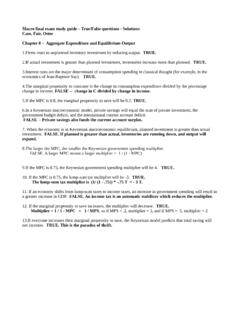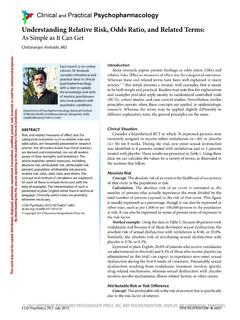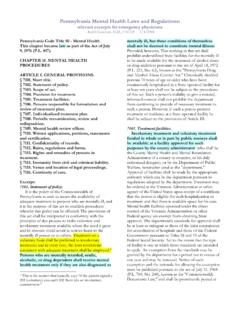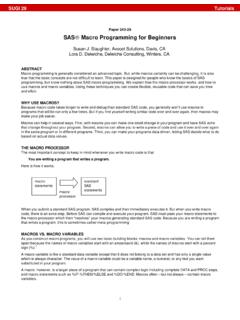Transcription of Macro Exam 2 Self Test -- ANSWERS Dr. McGahagan …
1 Macro Exam 2 Self Test -- ANSWERSDr. McGahaganWARNING -- Be sure to take the self-test before peeking at the 8 -- Aggregate Expenditure and Equilibrium Output_FALSE__1. Firms react to unplanned inventory investment by increasing output. Firms will react by reducing their orders until their undesired accumulation of inventory has been If actual investment is greater than planned investment, inventories decrease more than planned. Inventories will increase by more than planned. Actual investment = planned investment + unplanned inventory income is the major determinant of consumption spending in classical thought (for example, in the economics of Jean-Baptiste Say).
2 Classical economics held that interest rates determined saving, and hence consumption, since consumption = disposable income - savingKeynes shifted the focus to disposable marginal propensity to consume is the change in consumption expenditure divided by the change in disposable the MPC is , the marginal propensity to save will be MPC + MPS = ,since you must either consume or save every extra if the MPC = , the MPS must be the full Keynesian macroeconomic model, private savings of the citizens of a country will equal the sum of private investment, the government budget deficit, and the international current account international current account SURPLUS must be financed by the savings of the country which has the surplus, since the country they have a surplus with will have to borrow to pay for their GDP = C + I + G + NX GDP - T = C + I + G - T + NX (subtracting taxes from both sides)
3 Disposable income = C + I + Budget deficit + NXGDP - C - T = I + G - T + NXSavings = Investment + Budget deficit + net When the economy is in Keynesian macroeconomic equilibrium, planned investment is equal to actual larger the MPS, the smaller the Keynesian government spending the MPC is , the Keynesian government spending multiplier will be 4/3; that is, an increase of $ 300 billion in government spending will lead to an increase in GDP of $ 400 multiplier is 1 / (1 - MPC) = 1 / MPS = 1 = -- Chapter 8 - 2__FALSE___10. If the MPC is , the lump-sum tax multiplier will be -4, that is, an increase in taxes of $ 100 billion will lead to a drop in GDP of $ 400 billion.
4 The tax multiplier will be -3. Consider the simple Keynesian model with GDP = C + I + Gand C = .75 (GDP - T) Since GDP = .75 GDP - T + I + G, we have:.25 GDP = - T + I + G, or multiplying through by 4:GDP = T + 4 I + 4 G__FALSE__11. If an economy shifts from lump-sum taxes to income taxes, the government spending multiplier will be will be smaller. Consider the last question, with T = GDPGDP = .75(GDP - .2 GDP) + I + GGDP = .75( GDP) + I + GGDP = .6 GDP + I + GGDP - GDP = I + GDP = I + G, multiply through by 10 / 4 or to getGDP = I + GThe multiplier for government spending has fallen from 4 to If the marginal propensity to import increases, the multiplier will , like income taxes, are automatic everyone increases their marginal propensity to save, the Keynesian model predicts that total saving will not increase, and may is the paradox of thrift __FALSE__14.
5 In the equation C = Co + Cy (Y - T), we label the term Cy as induced consumption The term Cy is the marginal propensity to consume. The entire term, Cy (Y - T) is induced In the equation C = Co + Cy (Y - T) we label the Co term as autonomous consumption _FALSE_16. In a simple Keynesian economy with the above consumption equation, with Co = and Cy = and no foreign trade, a rise in investment of 200 billion would lead to a rise in GDP of 400 multiplier depends on the marginal propensity to consume of , not on autonomous In the simple Keynesian economy of the last question, a rise in investment of 200 billion and a simultaneous increase in taxes of 200 billion would lead to no change at all in balanced budget multiplier is one.
6 Using question 10 as an example, Since GDP = .75 GDP - T + I + G, we have if T = G (balance budget).25 GDP = - G + I + G, or .25 GDP = I + .25 G, and multiplying through by 4,GDP = 4 I + GSelf-Test -- Chapter 8 - 3_FALSE__18. A Keynesian cross representation of the consumption function of question 16 would have the consumption function, and hence also the planned aggregate expenditure line more steeply sloped than the 45 degree MPC is always less than one, so the PAE line will be PAE = MPC *( GDP - T) + I + G + slope of the PAE line is the 45 degree line represents the Keynesian equilibrium condition, so it has the equation PAE = GDPThe slope of the 45 degree line is The Keynesian cross representation of the consumption function was not the work of John Maynard Keynes, but of his father, John Neville Keynesian cross diagram is due to Keynes' student Joan The phrase Savings equals investment is a bit misleading, since savings must also finance the government budget deficit and any trade finances a country's trade surplus.
7 If we have a trade deficit, it will be financed by borrowingfrom other If consumers spend 80 cents out of each dollar of disposable income, we can conclude that the government spending multiplier in a simple Keynesian model is the consumption function will be C = (GDP -T), the multiplier will be 1 / (1 - MPC) or1 / MPS = 1 / = 9 -- The Government and Fiscal personal income is personal income minus taxes plus transfer actual investment is greater than planned investment, the economy is in danger of falling into a that firms will cut their future orders in order to work off the unplanned inventory G - T is positive, the government budget is in this back into words.
8 If G - T is positive, government spending is greater than investment increases, the planned aggregate expenditure line on the Keynesian cross diagram shifts the MPC increases, the planned aggregate expenditure line on the Keynesian cross diagram becomes slope of the PAE line is the MPC, if the MPC increases, the slope of the PAE line also a simple Keynesian model (with lump-sum taxes and a MPC of ), if the government increases spending by $400 billion and increases taxes by $400 billion, output will increase by $2000 the increase in government spending alone would have increased output by 5 times, the balanced budget multiplier is always one.
9 See the self-test, chapter 8, question 17for a fuller a simple Keynesian model (with lump-sum taxes and a MPC of ), a tax cut of $ 10 billion will have more of an impact on GDP than an increase in government spending of $ 10 the government spending multiplier is 5, the tax multiplier will be 4:Since GDP = C + I + G and C = (GDP - T), we have:GDP = .8 GDP - .8 T + I + G .2 GDP = T + I + GGDP = - 4 + 5 I + 5 taxes are given as a percentage of income, a higher tax rate implies a smaller government spending an open economy, the government spending multiplier will be higher than in an economy without international the marginal propensity to import is.
10 2, so IM = .2 GDP and the MPC is . a closed economy, the multiplier would be 5 (see problem 7 above)In an open economy, we would haveGDP = .8(GDP - T) + I + G + EX - MGDP = .8 GDP - .8 T + I + G + EX - .2 GDPGDP = .6 GDP - .8 T + I + G + GDP = - .8 T + I + G + EX; hence the new multiplier is for I, G and EX, and for taxes GDP = - T + I + G + EXSelf-Test -- Chapter 9 - 2_FALSE___10. If an economy has a marginal propensity to consume of and an income tax of 50 percent of income, the multiplier will be only half of what it would be with lump-sum sounds plausible ,but you must work through the numbers to see that it is a closed economy with MPC = , so C =.

















